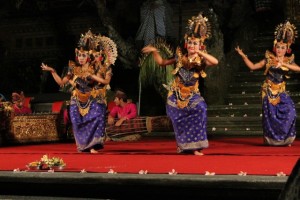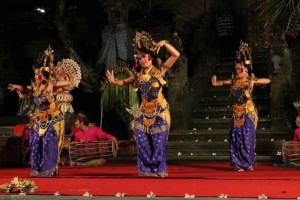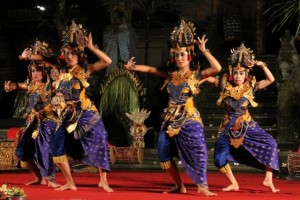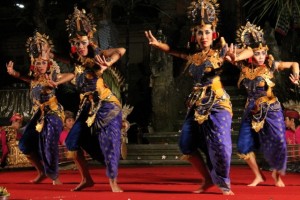Nope, we didn’t go out dancing in Bali, but we did watch a lot of dancing. Part of the fun of touring Bali is having the chance to see traditional Balinese dancing. We caught our first performance a couple of days after getting to Ubud, at the small Pura Saraswati temple that’s surrounded by a water garden filled with giant lotus blossoms. The performance included a sampling of different Balinese styles of dance, all accompanied by a gamelan, a Balinese orchestra of sorts that involved what seemed to be a lot of xylophones, drums, and gongs. (John would be much better at describing the music than I am.) The first dance that night was the legong, a style we would see again later during our visit in Ubud. Balinese dancing in general is very different than western styles of dancing, and legong is slow moving and involves strange and intricate hand and foot movements and dramatic facial expressions. That night, the dancers performed the first half of the legong with their eyes shut–I don’t know how they knew their way around the stage, but they performed the dance totally synchronized.
Next up was the kebyar duduk, a solo male dance that is mostly performed in a seated position, and is designed to be responsive to the music that the gamelan is playing.
That was followed by the fisherman dance, where the three dancers acted out the life of fishermen as they fish to earn their living.
Then the baris warrior dance, performed by an adolescent boy to reenact the emotions he’ll experience as he prepares to become a warrior and go to battle.
Finally the nyamar dance, which is based on an old Javanese story about a couple in love that has been forcibly separated but that reunites just in time for the woman to stop the man’s marriage to an evil impostor.
Later during our Bali visit, when we were visiting the south part of the island, we saw a sunset performance of the kecak dance at Pura Luhur Uluwatu, a huge temple complex at the southern tip of Bali that overlooks the Indian Ocean. The kecak was a totally different kind of dance. Instead of a gamelan orchestra, a group of men surrounding a bonfire chant the word “kecak” over and over again at different speeds and rhythms to create a musical sound. Then, while the men are chanting, dancers perform the ramayana, an ancient Hindu epic tale originating in India. It tells the story of Rama, who represents the god Vishnu, and Rama’s wife Sita, who is abducted by the evil king Ravana. With the help of some magical monkeys, Rama is able to rescue Sita and bring her home. The performance was packed with Japanese tourists, and we got a kick out of their “oohs” and “aahs” that they murmured at different points during the show. Here are some pictures of the kecak dance, along with a video that really gives you a sense of what it sounds like.












